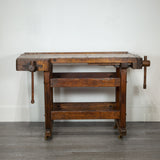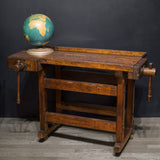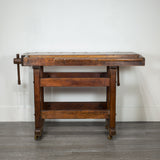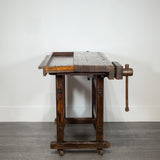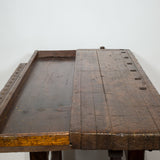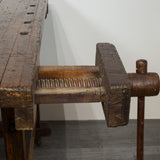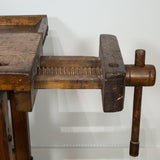S16 Home
Black Walnut and Douglas Fir American Carpenter's Workbench c.1900
ABOUT
This is an original early 20th century American carpenter's workbench. The work surface is Black Walnut with a large tray in the back. The tray has an inlay section for tools along the width of the back. There are 7 dogs spaced along the width of the front. The base of this work bench is made from Douglas Fir and has vintage leather and brass casters. The bench features two all wooden vises that both extend 13 inches. The piece is structurally sound and has retained the naturally distressed look of an industrial piece of this kind.
- CREATOR Unknown.
- DATE OF MANUFACTURE c.1900
- MATERIALS AND TECHNIQUES Black Walnut, Douglas Fir.
- CONDITION Excellent. Wear consistent with age and use.
- DIMENSIONS H 34.5 in. x D 31 in. W 54 in. (Tray H 1.25 in. D 9 in. W 36 in. Casters H 2.75)
HISTORY
A workbench is essentially a table fitted with various holding devices, such as benchstops and vises, made sufficiently strong and massive to be used for a variety of woodworking operations. The modern workbench derives from two separate pieces: a table for planing wood and a bench for supporting wood to be sawn.
Designs have changed over the centuries, beginning with low Roman planing benches and slowly growing in height to present day hand-high benches, and acquiring different accessories. French benches of the 17th and 18th centuries, for example, depended largely on stops and dogs to hold the workpiece, whereas British and American benches relied more on various vises (which first appeared on medieval German benches). How and where vises are fitted further differentiates between different bench types, the most common of which are those known as the standard cabinetmaker's bench (fitted with a face vise and a tail vise).
